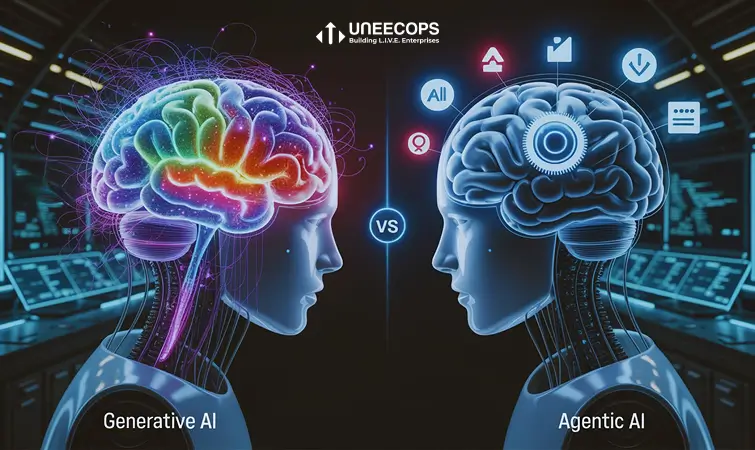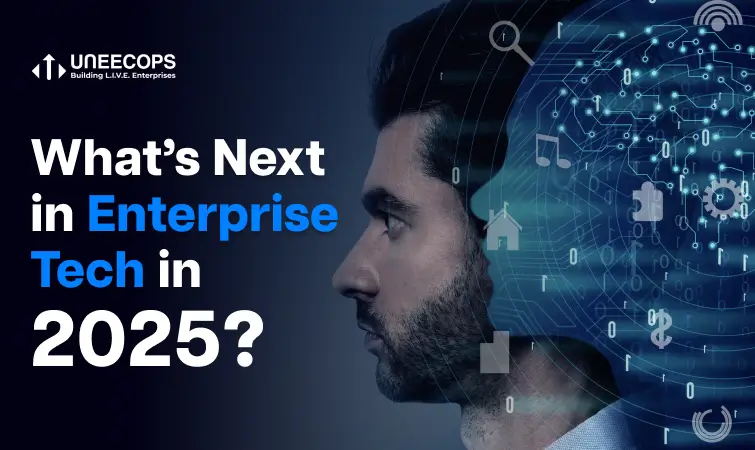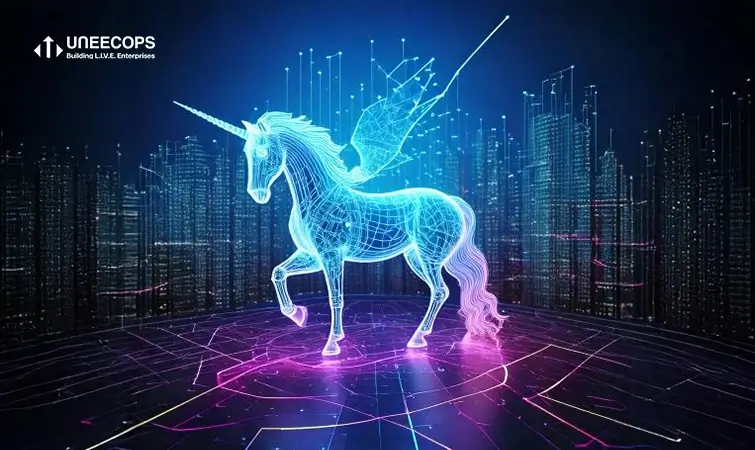AI’s rapid integration into modern technological functioning has already split it into several branches according to its roles, differences, and use cases across various sectors. Two of such new developments are in the form of agentic AI vs generative AI. The emergence of gen AI vs AI of agentic nature has sparked discussions on their future prospects and possibilities.
One thing is very evident: the AI branches of agentic AI and generative AI are very advanced yet distinct in fundamentals from each other. They offer diverse options for automation and autonomy. Therefore, it is crucial to be clear about their real-world use cases and practical applications to understand the obvious and also the hidden differences between them.
With a more practical and real-world approach, with the help of this article, we will understand the nature and use cases of agentic AI vs generative AI in the modern world.
What Makes Them Tick? Key Features of Agentic and Generative AI
a. Goal Orientation
- Agentic AI: Agentic AI works with greater autonomy and can create, schedule, and implement goals without any manual interventions.
- Generative AI : Generative AI doesn’t have such autonomy, and it mainly works based on prompts entered by a user. It only implements goals given to it by a user and cannot create goals of its own.
b. Memory
- Agentic AI: The AI agents with the Agentic Framework have long-term memory and can even consistently look back on their previous data to learn and adapt for greater output.
- Generative AI: Generative AI tools have very short-term memory that is based on sessions or prompts. However, in some special cases, it can have long-term memory, but only when specially programmed.
c. Interaction with the Environment
- Agentic AI: Agentic AI is very ergonomic and streamlined as it can easily interact with all kinds of external applications and environments to execute its goals.
- Generative AI: Generative AI is mostly restricted to its application and does not operate outside of its environment without a manual integration with that particular third-party application.
d. Reasoning
- Agentic AI: Agentic AI has a powerful long-term reasoning capacity, using which it can dissect a larger goal into smaller short-term objectives and carry them out precisely.
- Generative AI: Generative AI can also carry out tasks with proper logic but lacks the ability to autonomously plan and reason out a perfect strategy on its own.
e. Initiative
- Agentic AI: Agentic AI is very high on initiative and undertaking. It can re-plan strategies and timelines for executing objectives without needing any external assistance.
- Generative AI: Generative AI is not initiative but rather reactive. It only performs and executes tasks when asked to.
The Thinker vs. The Creator: Breaking Down Agentic and Generative AI
a. Purpose and Autonomy
The main aspect of understanding the Gen AI vs AI of agentic nature discussion is having complete clarity about the differences in autonomy and purpose of these Agentic AI vs generative AI systems.
- Generative AI
As its name suggests, Generative AI is more media-driven, where its major function is to generate images, text replies, videos, music, and even code according to the prompt input by humans. Gen AI is responsive and is only active when someone is on the other side of the system, asking it to generate something creative or informational. ChatGPT is the perfect example of Gen AI. However, countless ChatGPT users fall into the false bias of thinking of AI vs generative AI as the same thing. When, in reality, Gen AI is just one of many other advanced branches of artificial intelligence. Gen AI’s purpose is to create content and allow individuals to generate personal media items.
- Agentic AI
The Agentic AI is way more autonomous and independent than Gen AI. It doesn’t require any human prompt to take actions or perform tasks. Agentic AI is capable of making informed decisions and even acting on them on its own. This is one of the major differences discovered in the agentic AI vs generative AI debate. Agentic AI is more futuristic and advanced as it empowers autonomous agents to carry out tasks and make decisions without any human intervention.
Having a knowledge of this stark fundamental divide between agentic AI vs generative AI is the key when implementing them in real-world applications.
b. Workflow and Decision-Making
The discussion about the real-world uses of agentic AI vs generative AI is incomplete without knowing the differences in their nature and type of workflow.
- Generative AI
Gen AI, especially in tools like ChatGPT, functions in a linear workflow, i.e., they can only perform a single task at a time. Their whole workflow is dependent on inputs and outputs. A user enters a prompt, and then the Gen AI will provide an appropriate output based on that specific request. And, even though this response is very efficient there is still not much room for autonomy left.
- Agentic AI
Agentic AI has a more complex and advanced workflow with multiple steps that are all interconnected with each other like a web. It has a pre-programmed machine learning algorithm that does everything from planning, executing, learning, and adapting to a new environment. And, all of this is done with complete autonomy without any need for manual input. For example, an agent of Agentic AI not only generates an output, but also plans, researches, schedules, and even creates newer strategies with time based on previous data.
It is this level of autonomy and powerful workflow that creates a major use case difference between the typical Gen AI vs AI of Agentic nature. However, this doesn’t discount the uses of Gen AI in our modern technological world because Gen AI is itself an upgrade from traditional AI systems. There is no comparison between traditional AI vs generative AI because traditional AI systems have already become outdated due to their strict rule-based nature.
The reason why Gen AI took over was because of its creative and adaptive functionality that is well-suited for this fast-paced world. And, now, Agentic AI has gone even one step further and has added even more autonomy to the workflow.
Smart Action or Creative Output? How Agentic & Generative AI Are Used Today
a. Generative AI Use Cases
- Creating Text Content
Gen AI is widely used and highly popular across the world due to its capacity to create engaging content that is relevant and rich in substance. Companies have already adopted it to churn out blog pieces, news articles, ad copies, and other text content. It provides a cost-effective solution for businesses to scale their content marketing campaigns without affecting their quality or efficiency.
- Image Creation
Gen AI is also heavily used for generating creative images in numerous art styles and creative outlooks. Companies are using numerous AI image-generation tools to create eye-catching ads, promotional banners, and designs without much effort. Also, these tools make the work easier for designers and graphic artists by recommending newer ideas and concepts. Overall, Gen AI’s image generation capability is being heavily utilized for marketing, branding, and developing new concepts.
- Generating Coding
Another major use case of Gen AI is now being seen in the software industry, where coders are using it to generate code, find bugs, etc.This allows even non-coding professionals to generate code solely based on prompts.
- ChatBots
Gen AI chatbots are rapidly replacing human live support due to their 24/7 availability and higher operational efficiency. They generate quick and relevant replies to human queries.
b. Agentic AI Use Cases
- Automated IT Support
The integration of Agentic AI in IT systems has completely overhauled the entire functionality and efficiency. Atera, an Agentic AI platform, offers autonomous AI agents that auto-detect any system errors and then automatically fix them without any human input. This drastically reduces the downtimes experienced by the business and boosts overall productivity and efficiency.
- Personal AI Assistants
The major difference between the personal agents of Agentic AI vs generative AI is the level of autonomy and decision-making. Agentic AI assistants can not only set up reminders and schedules but also make changes to them based on newer data. They do all this scheduling and booking of appointments autonomously without any human inputs or interventions.
- Autonomous Business Workflows
Businesses such as Kanerika have developed advanced Agentic AI systems that can autonomously manage the entire business workflow on their own. It can automate sales, manage HR tasks, and even make well-informed decisions and quickly prepare itself for the latest environmental setting without any external prompts.
- Robotics
The integration of Agentic AI in robotics is probably the most impactful and futuristic endeavor. Companies like IBM are working on Agentic AI robots to solve logistics issues. Robots with Agentic AI systems can move around stocks, navigate the entire warehouse, and take action on their own. This makes the work of humans easier by removing the need for physical assistance in repetitive jobs
Looking Ahead: AI That Acts, AI That Creates
Overall, these were the major talking points and use case differences between Agentic AI vs Generative AI. We saw how gen AI is an ideal system for content creation, image generation, and other creative pursuits. Meanwhile, Agentic AI is a more autonomous and powerful system that takes independent actions and adapts to newer situations on its own without any human prompts.
The major difference between Agentic AI vs Generative AI is more than just technical, it shows the right integration path to make the most of them in real-world scenarios. Businesses and organizations that are looking to integrate AI to optimize their operations and workflow will now have greater clarity in choosing the right AI tools and systems for their specific goals. Thankfully, this modern digital world offers tons of options and advanced tools to pick from for businesses to scale and grow at speeds that were previously unimaginable.







